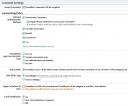
I’ve been testing the beta version of Movable Type 4 today and I must say I am really impressed.
Yes it is beta.
Yes there are bugs, but it’s beta software. What do you expect?
The development team will fix the bugs and release a very tasty piece of software once they are happy with it.
So what’s it like?
One of the things about MovableType that always annoyed me to a degree was the install process. If you are confident with Perl, paths, chmod etc., then installation isn’t that hard, but I always felt that it alienated a lot of users. (This is probably where WordPress picked up a lot of its user base).
The new installer is a hell of a lot more intuitive.
Once you’ve uploaded the files into the correct locations you can go to the blog URL (mt.cgi) and the installer starts. After answering a few simple questions it should send a test email and your blog is pretty much up and running.
Okay, admittedly there is a bit of tweaking of permissions that you need to do before the install works as described, but they’re not real “show stoppers” and the beta testers are reporting issues as they find them.
As Movable Type is a multi-blog and multi-user environment you can manage multiple blogs from the same backend easily. This is a feature that has been around for ages and is one of the reasons I will probably move a lot of my blogs over to the platform once it comes out of beta.
Once you login for the first time you should configure the various settings. Settings and configuration options work on two levels:
- System wide
- Blog specific
This can be a small bit confusing if you aren’t used to the concept, but the navigation menu makes it quite easy to navigate around.
The initial login / welcome screen gives you a summary of the recent activity:

As the default user is also the system admin, you can tweak settings at both a system and blog level from the dropdown menus:
For the entire system using the upper menu:

For the blog you are working on with the central one:

Template configuration options have definitely improved, or at least they seem to be that bit more accessible.
Other little options that caught my attention were things like the trackback settings. You can easily disable the “nofollow” attribute with one click (it’s on by default).
Comment spam is always a touchy subject and one of the things that MT has always been pretty good at was offering various levels of authentication for commenters. The new version takes this a step further:

The “native” method uses a standard image based captcha, which isn’t particularly user-friendly. I’d be a lot happier with more options for this one eg. text based
They’ve also added support for OpenId which seems to be gaining in popularity.
Of course once you’ve setup your blogging software to “play nice” you want to actually use it to produce content.
The main login screen (see screenshot above) has a nice big friendly “write entry” button that you can’t miss.
The software seems to be all about customisation and ease of use, so you can choose which elements to display in the composition window. The current version doesn’t seem to have sane defaults, but that will hopefully be remedied in a later version.
The rich text editor is really nice (unlike WordPress’!) and handles most tasks admirably. The one task that I couldn’t get working was the image insert and upload feature, so I filed a bug report.
Similar to WordPress there is an auto-save feature for draft posts, though the current version seems to only store one entry and doesn’t mark it as a “draft”.
One of the main differences between WP and MT is the way that entries are stored, which has a direct impact on performance. Regardless of what any of the WP developers may claim WordPress can be a resource hog in its default configuration, as each and every page view requires the database to be queried multiple times.
With Movable Type, however, all the entries are stored on disk as actual files. The only downside to this is that if you make any significant changes to your templates you have to wait while the system rebuilds all the files out to disk.
In the new version the publishing options haven’t changed from before, though longer file names seem to be possible (I could be wrong). The one niggly annoyance is that you can’t specify the build format easily ie. choosing between hyphens and underscores in the output files. It defaults to using underscores.
However other aspects of the templating system make it a lot more seo-friendly out of the box. If you want to remove the blog name from the individual entries you simply edit one portion of a template, as it’s already contained in a nice little “if” statement.
The other nifty thing is that you can easily add other RSS feeds into your template (it took me about 30 seconds to add one) using either the URL to the feed or simple auto-discovery which is really cool.
Overall I’m quite impressed and will be very interested to see how things pan out.
A very boring test install of MT4 Beta 1 is over on mneylon.kz if anyone wants to look at it







Beta shmeta, you gotta hate buzzwords.
Looks quite impressive from the write-up there.
I love the idea of the static files because sometimes it is scary to see the number of queries on some of your pages and other people’s WordPress sites. I think WordPress is a great piece of software in the human sense that it is made for the writer, not for the software system and it is so uniquely hackable(the good sense).
However, I still think WordPress is lacking in the code design and has some performance issues when it comes to scaling up (I have wondered what performance would be like on WordPress.com if they used MovableType or some other software based on a faster language, especially with static files like MT)
David
Beta isn’t a buzzword if it’s used properly 🙂
MT v4 is beta ie. it’s not 100% functional and is not ready for mass consumption.
The problem is that a lot of people in the web 2.0 camp seem to think that “beta” equates with “trendy”, so they’re abusing the term.
Michele
Of course you are right that it should not be a buzzword but I think “Beta” and “Alpha” and the like are used to much on web services and web apps to excuse the decision to release the product early even with bugs and without much testing.
David
Yes, but in the case of MT it truly is a beta ie. just for testing and bugfixing 🙂
Michele